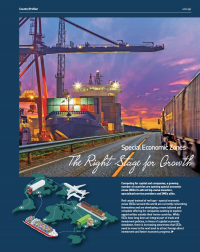Report: Special Economic Zones
Media: Lufthansa Inflight Magazine
Sector: Trade & Foreign Direct Investment (FDI)
Publication Date: September 2016
Special Economic Zones
The Right Stage for Growth
Competing for capital and companies, a growing number of countries are opening special economic zones (SEZs) to attract big-name investors, specialised service providers and SMEs alike.
Red carpet instead of red tape – special economic zones (SEZs) around the world are currently reinventing themselves and are developing a more tailored and complete offering for companies seeking to explore opportunities outside their home countries. While SEZs have long been an integral part of trade and investment policies, in times of a global economic slowdown, there is increasing awareness that SEZs need to move to the next level to attract foreign direct investment and foster economic progress.
Evolving Concept
Special economic zones have been around for much longer than many people might think, with the first modern one being established at Shannon airport in Ireland in 1959. In the 1980s, China truly embraced the concept when it decided to create a zone in Shenzhen that transformed the city into an export powerhouse. Thanks to its SEZ, Shenzhen has become a metropolis that is home to some 18 million people, and its growth story has been dubbed ‘The Miracle of Shenzhen’. Since then, authorities in China and all over the world have expanded the number and scope of SEZs. It is estimated that there are close to 4,500 SEZs globally, and according to The Economist three out of every four countries have set up at least one economic zone. Today, a variety of different setups are subsumed under the SEZ concept, including export processing zones, free zones, free trade zones, industrial parks, as well as science and innovation parks to name but a few. Besides China, countries such as Singapore, Malaysia, the UAE, South Korea, Jordan, and Panama are home to some of the most admired SEZs.
SEZs Offering
These zones have succeeded in providing the right business environment, while putting policies in place that allow companies to grow and thrive. SEZs usually offer tax incentives for companies investing in the designated areas, trade and customs benefits, as well as streamlined regulatory processes. They are given a business environment that is more liberal and more effective than that of the national territory. Not all SEZs are equal and suitable for any kind of operation. Corporate managers and planners are urged to compare the different offerings carefully when scouting potential locations. In fact, many zones today have a specialised focus, ranging from cluster activities in areas such as pharmaceuticals, automotive, maritime and aerospace to dedicated support services for smaller companies and even start-ups – signalling an important shift compared to a focus on attracting large multinationals in previous years.
Mixed Results
While there have been many SEZs success stories, there have also been failures. In particular SEZs in Sub-Sahara Africa are struggling to take off. Some clusters have promised industrial development and employment, only to incur heavy costs for governments and taxpayers. Observers say that some were not even fulfilling the basic requirements to attract investment: a good labour supply, transport connectivity and a strategic location. Analysts emphasise that improving infrastructure – in particular through investment in roads, railways and ports – can have a bigger impact on the success of a zone than tax incentives. Despite their mixed reputation, SEZ also have advantages. They are widely seen as a way to support wider economic reform strategies, as well as allowing economic policy makers to experiment with strategies and regulations that might be difficult to push through nationwide. However, too much government interference can also mean SEZs lose their competitive edge to achieve far-reaching economic transformations. In an effort to strengthen their ability to innovate, many economic zones have already seen the transition from government to private sector management.
The Next Generation Zone
Economic zones around the world are now seeking to up the ante in what they offer. Successful next-generation clusters not only provide world-class infrastructure and financial incentives that attract businesses in the short term, but seek to differentiate themselves from their competitors. Sector specialisation will gain in importance, with special economic zones becoming truly special and a magnet for companies operating in the target industry. As more smaller and medium-sized companies seek to tap markets outside their home country, there is also demand for more sophisticated support services in areas such as marketing, distribution, access to capital and financing as well as talent and technology development. Economic zones of the future will not only provide a plug-and-play environment for companies but will support them in identifying business avenues and seizing new opportunities.
 Related Content
Related Content
The Right Stage for Growth
Competing for capital and companies, a growing number of countries are opening special economic zones (SEZs) to attract big-name investors, specialised service providers and SMEs alike.
Special Economic Zones
Competing for capital and companies, a growing number of countries are opening special economic zones (SEZs) to attract big-name investors, specialised service providers and SMEs alike.
A Model Industrial Park
The Aegean Free Zone has become the partner of choice for more than 170 companies and a competitive location for high-tech industries.
Gateway to Global Markets
Morocco’s Tanger Med Zones have quietly emerged as a manufacturing and distribution hub for international companies.
Report Sponsors






